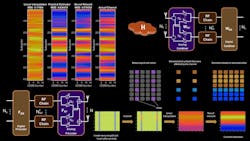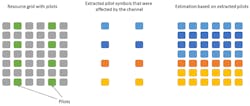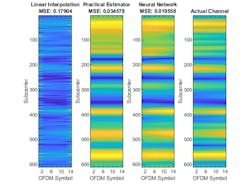Algorithms to Antenna: 5G Channel Estimation Using Deep-Learning Techniques
This blog is part of the Algorithms to Antenna Series
What you'll learn:
- What is channel estimation?
- How is channel estimation performed?
- The role of CNNs in 5G channel estimation.
Several of our more recent blogs have focused on applying deep learning to wireless and radar applications. For reference, they are:
In this blog, we will extend the discussion to channel estimation in 5G systems. First, some background. Transmitted RF signals in wireless communications systems propagate through the environment to a receiver. Channel propagation results in changes to the signal, including loss, noise, distortions, and Doppler shifts.
To recover transmitted signals, we need to remove the effects introduced by the channel from the received signal. First, we estimate the channel characteristics. In a system like that in Figure 1, this involves estimating the characteristics of the channel represented by H. Knowing this information allows us to apply signal processing to remove the effects introduced by the channel after we demodulate and decode the signal.
A general approach to channel estimation is to insert known reference pilot symbols into the transmission. Then the rest of the channel response is interpolated by using these pilot symbols as shown in Figure 2.
To perform channel estimation, we train a convolutional neural network (CNN) using data generated with 5G Toolbox. Using the trained CNN, channel estimation is performed in single-input single-output (SISO) mode, utilizing the physical downlink shared channel (PDSCH) demodulation reference signal (DM-RS). Later, we will also compare the results using the CNN with practical and perfect versions of the channel estimator.
To apply deep-learning techniques to a channel-estimation system, we represent the resource grid as a 2D image. This transforms the approach into an image-processing problem, similar to denoising or super-resolution, where CNNs also are often used.
We generate customized standard-compliant waveforms and channel models to use as our training data. Training data is required for the CNN to learn information about the channel. Then the trained channel-estimation CNN is used to process images that contain linearly interpolated received pilot symbols (Fig. 3). You can see how the extracted pilot symbols on the left portion are used to estimate the remaining portions of the channel.
Our channel-estimation CNN is trained on various channel configurations based on different delay spreads, Doppler shifts, and signal-to-noise ratio (SNR) ranges between 0 and 10 dB.
To simulate a PDSCH transmission, we perform the following steps:
- Generate PDSCH DM-RS and map/insert into the resource grid.
- Perform orthogonal frequency-division multiplexing (OFDM) modulation.
- Send modulated waveform through the channel model.
- Add white Gaussian noise.
- Perform perfect timing synchronization.
- Perform OFDM demodulation.
You can use perfect, practical, and neural-network estimations of the same channel model and compare their performance. 5G Toolbox has functions to perform both perfect and practical channel estimations, which we use below in our comparison.
To perform channel estimation using the neural network, you must interpolate the received grid. Then split the interpolated image into its real and imaginary parts and input these images together into the neural network as a single batch.
In Figure 4, you can see the mean squared error (MSE) of each estimation method, including the individual channel estimations and the actual channel realization obtained from the channel path gains and filter taps. The neural-network estimator achieves the best results and both the practical estimator and the neural-network estimator outperform linear interpolation.
This type of channel estimation can be extended to other wireless applications.
Rick Gentile is Product Manager, Daniel Garcia-Alis is Development Manager, Carlos Lopez is Senior Developer, and Honglei Chen is Principal Engineer at MathWorks.
To learn more about the topics covered in this blog and explore your own designs, see the examples below or email me at [email protected]:
- Deep Learning Data Synthesis for 5G Channel Estimation (example): Learn how to use a trained CNN to perform channel estimation in single-input single-output (SISO) mode, utilizing the physical downlink shared channel (PDSCH) demodulation reference signal (DM-RS).
- NR PDSCH Throughput (examples) – Learn how to measure the physical downlink shared channel (PDSCH) throughput of a 5G New Radio (NR) link, as defined by the 3GPP NR standard.
- Deep Learning in Wireless Systems (examples) – Learn how deep-learning techniques can be applied to wireless applications.
See additional 5G, radar, and EW resources, including those referenced in previous blog posts.
About the Author
Rick Gentile
Product Manager, Phased Array System Toolbox and Signal Processing Toolbox
Rick Gentile is the product manager for Phased Array System Toolbox and Signal Processing Toolbox at MathWorks. Prior to joining MathWorks, Rick was a radar systems engineer at MITRE and MIT Lincoln Laboratory, where he worked on the development of several large radar systems. Rick also was a DSP applications engineer at Analog Devices, where he led embedded processor and system level architecture definitions for high performance signal processing systems used in a wide range of applications.
He received a BS in electrical and computer engineering from the University of Massachusetts, Amherst, and an MS in electrical and computer engineering from Northeastern University, where his focus areas of study included microwave engineering, communications, and signal processing.




